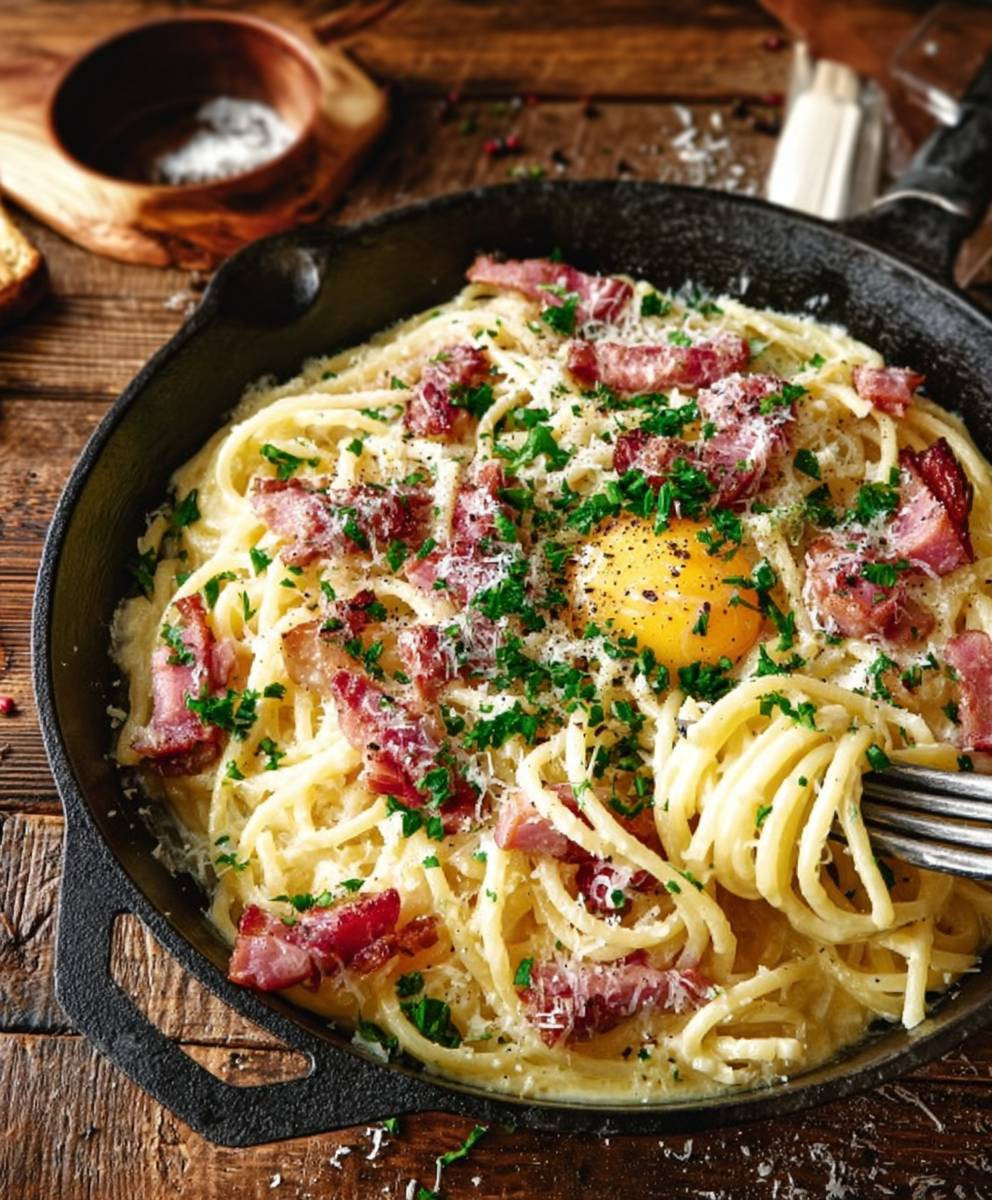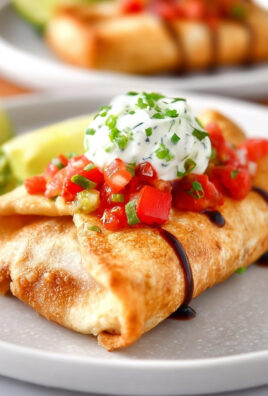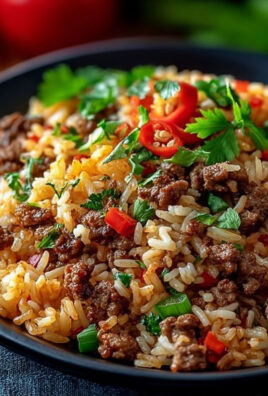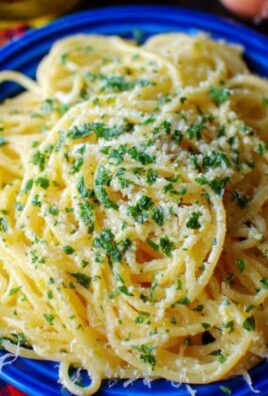Italian Spaghetti Carbonara: just the name conjures images of creamy, decadent pasta, doesn’t it? Forget those jarred sauces and overly complicated recipes; we’re diving headfirst into the authentic, soul-satisfying simplicity of true Italian comfort food. Have you ever wondered how just a handful of ingredients can create such an explosion of flavor? This isn’t just a pasta dish; it’s a culinary experience, a taste of Roman history on your plate.
The origins of Spaghetti Carbonara are debated, but many believe it emerged in Rome during or shortly after World War II. Some theories suggest it was created to satisfy the cravings of American soldiers, combining readily available ingredients like eggs and bacon (or pancetta) with the classic Italian pasta. Whatever its true beginnings, Italian Spaghetti Carbonara has become a beloved staple worldwide.
What makes this dish so irresistible? It’s the perfect marriage of textures: the al dente spaghetti, the crispy guanciale (or pancetta), and the rich, velvety sauce clinging to every strand. The salty, savory flavors are perfectly balanced by the creamy egg yolks and a generous grating of Pecorino Romano cheese. Plus, it’s incredibly quick and easy to make, making it a perfect weeknight meal that feels like a special occasion. Get ready to impress your family and friends with this classic Italian masterpiece!
Ingredients:
- 1 pound spaghetti
- 6 ounces guanciale, pancetta, or bacon, cut into 1/4-inch dice
- 4 large eggs
- 1 cup grated Pecorino Romano cheese, plus more for serving
- 1/2 cup grated Parmesan cheese
- Freshly ground black pepper, to taste (at least 1 teaspoon)
- 2 tablespoons olive oil (optional, if guanciale is lean)
- Salt, for pasta water
Preparing the Guanciale (or Pancetta/Bacon):
Okay, let’s start with the heart of Carbonara – the cured pork! Whether you’re using guanciale, pancetta, or bacon, the preparation is pretty much the same. The key is to render the fat properly to create that delicious, crispy texture and flavorful oil that coats the spaghetti.
- Dice the Pork: If you haven’t already, cut your guanciale, pancetta, or bacon into 1/4-inch dice. Try to keep the pieces relatively uniform in size so they cook evenly.
- Render the Fat: Place the diced pork in a large skillet or frying pan over medium heat. If your guanciale is particularly lean, you might want to add a tablespoon or two of olive oil to the pan to get things started. This will help prevent the pork from sticking and ensure it renders its fat properly.
- Cook Until Crispy: Cook the pork, stirring occasionally, until it’s golden brown and crispy. This usually takes about 8-12 minutes, depending on the thickness and fat content of your pork. Be patient and don’t rush the process. The rendered fat is crucial for the flavor of the dish.
- Remove from Heat: Once the pork is crispy, remove the skillet from the heat. Carefully transfer the crispy pork to a plate lined with paper towels to drain any excess fat. Reserve the rendered fat in the skillet – this is liquid gold! Let the fat cool slightly.
Preparing the Cheese and Egg Mixture:
Now, let’s move on to the creamy, cheesy sauce that makes Carbonara so irresistible. This part is all about getting the right consistency and preventing the eggs from scrambling. The key is to work quickly and use the hot pasta water to temper the eggs.
- Grate the Cheese: In a large bowl, combine the grated Pecorino Romano and Parmesan cheese. Make sure you’re using freshly grated cheese – it makes a huge difference in flavor and texture. Pre-grated cheese often contains cellulose, which can prevent it from melting smoothly.
- Whisk the Eggs: In a separate bowl, whisk together the eggs. You want to break up the yolks and whites completely, creating a smooth and even mixture.
- Combine Cheese and Eggs: Pour the whisked eggs into the bowl with the grated cheese. Add a generous amount of freshly ground black pepper – at least 1 teaspoon, or more to taste. Don’t be shy with the pepper; it adds a wonderful depth of flavor to the dish.
- Mix Well: Use a fork or whisk to thoroughly combine the eggs, cheese, and pepper. The mixture should be thick and slightly pasty. Set aside.
Cooking the Spaghetti:
While the pork is rendering and the cheese and egg mixture is ready, it’s time to cook the spaghetti. The pasta should be cooked al dente, meaning it’s firm to the bite. And don’t forget to reserve some of the pasta water – it’s essential for creating the perfect Carbonara sauce.
- Bring Water to a Boil: Fill a large pot with plenty of water (at least 6 quarts). Add a generous amount of salt – the water should taste like the sea. This seasons the pasta from the inside out. Bring the water to a rolling boil over high heat.
- Cook the Spaghetti: Add the spaghetti to the boiling water and cook according to the package directions, or until al dente. Start checking for doneness a minute or two before the recommended cooking time.
- Reserve Pasta Water: Before draining the pasta, use a measuring cup to reserve about 1 cup of the starchy pasta water. This water is crucial for creating the creamy sauce and preventing the eggs from scrambling.
- Drain the Pasta: Drain the spaghetti in a colander. Don’t rinse the pasta – you want to keep the starch on the surface to help the sauce cling to it.
Assembling the Carbonara:
This is where the magic happens! The key is to work quickly and efficiently to combine the hot pasta, rendered pork fat, and cheese and egg mixture. The heat from the pasta will gently cook the eggs, creating a creamy, luscious sauce.
- Combine Pasta and Pork Fat: Immediately add the drained spaghetti to the skillet with the reserved rendered pork fat. Toss the pasta well to coat it evenly with the fat. This will help prevent the pasta from sticking together and add a ton of flavor.
- Add the Cheese and Egg Mixture: Remove the skillet from the heat. Pour the cheese and egg mixture over the hot pasta. Working quickly, toss the pasta vigorously with tongs or a large fork to combine everything. The heat from the pasta will gently cook the eggs, creating a creamy sauce.
- Add Pasta Water (if needed): If the sauce is too thick, add a little of the reserved pasta water, one tablespoon at a time, until you reach your desired consistency. The sauce should be creamy and coat the pasta evenly. Be careful not to add too much water, or the sauce will become too thin.
- Incorporate Crispy Pork: Add most of the crispy guanciale, pancetta, or bacon to the pasta and toss to combine. Reserve a little of the crispy pork for garnish.
- Serve Immediately: Serve the Carbonara immediately in warmed bowls. Garnish with the remaining crispy pork, a generous grating of Pecorino Romano cheese, and a final sprinkle of freshly ground black pepper.
Tips for Success:
- Use High-Quality Ingredients: The quality of your ingredients will directly impact the flavor of your Carbonara. Use fresh, high-quality eggs, freshly grated cheese, and good-quality guanciale, pancetta, or bacon.
- Don’t Overcook the Pasta: Overcooked pasta will be mushy and won’t hold the sauce well. Cook the spaghetti al dente, meaning it’s firm to the bite.
- Work Quickly: The key to a creamy Carbonara sauce is to work quickly and efficiently. The heat from the pasta will gently cook the eggs, creating a smooth and luscious sauce.
- Don’t Scramble the Eggs: To prevent the eggs from scrambling, remove the skillet from the heat before adding the cheese and egg mixture. Toss the pasta vigorously to combine everything, and add pasta water if needed to adjust the consistency.
- Adjust Seasoning: Taste the Carbonara before serving and adjust the seasoning as needed. You may need to add more salt, pepper, or cheese to taste.
Variations:
- Vegetarian Carbonara: For a vegetarian version, you can substitute the guanciale, pancetta, or bacon with sautéed mushrooms or other vegetables.
- Spicy Carbonara: Add a pinch of red pepper flakes to the cheese and egg mixture for a spicy kick.
- Smoked Paprika: Add a pinch of smoked paprika to the rendered fat for a smoky flavor.
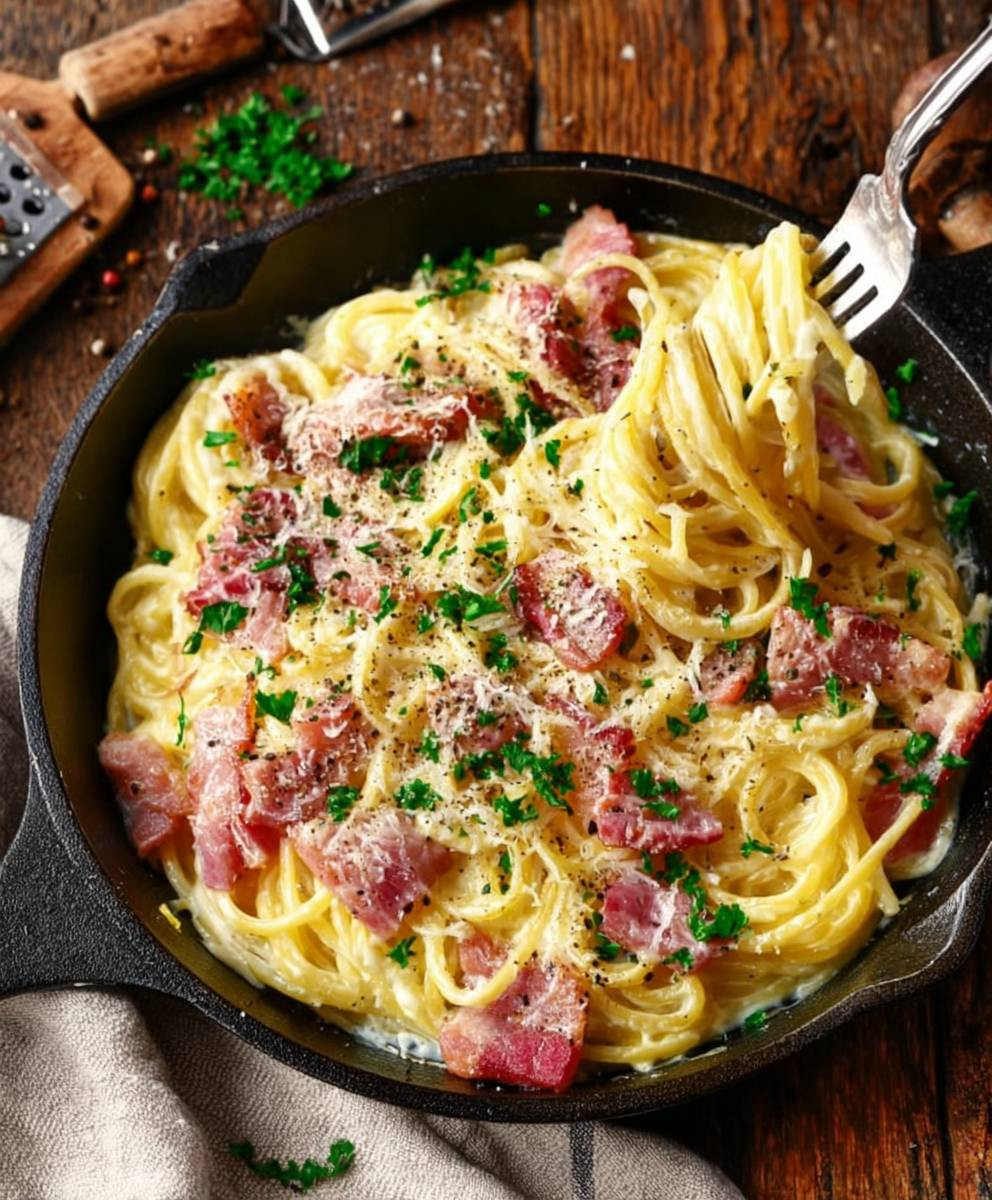
Conclusion:
This isn’t just another pasta dish; it’s a journey to the heart of Italy, a celebration of simple ingredients transformed into something truly extraordinary. The creamy, decadent sauce, the perfectly cooked spaghetti, and the salty, savory guanciale all come together in a symphony of flavors that will leave you craving more. Trust me, once you’ve tasted authentic Italian Spaghetti Carbonara made from scratch, you’ll never look at the jarred stuff the same way again. It’s a must-try for any pasta lover, a guaranteed crowd-pleaser, and surprisingly easy to master with a little practice.
But the beauty of cooking lies in its adaptability! While this recipe is a classic for a reason, don’t be afraid to experiment and make it your own.
Serving Suggestions and Variations:
* Elevate the Experience: Serve your Carbonara with a generous grating of Pecorino Romano cheese and a sprinkle of freshly cracked black pepper. A side of crusty Italian bread is perfect for soaking up every last bit of that delicious sauce.
* Wine Pairing: A crisp, dry white wine like Pinot Grigio or a light-bodied red like Chianti will complement the richness of the dish beautifully.
* Spice it Up: Add a pinch of red pepper flakes to the sauce for a little extra heat.
* Vegetarian Option: While traditionally made with guanciale, you can substitute it with smoked tofu or mushrooms for a vegetarian-friendly version. Just be sure to sauté them until they’re nicely browned to add that savory depth of flavor.
* Add Some Greens: Toss in some wilted spinach or arugula at the end for a boost of nutrients and a pop of color.
* Egg Yolk Enrichment: For an even richer sauce, reserve an extra egg yolk per serving and whisk it into the pasta just before serving. This will create an incredibly creamy and luxurious texture.
* Pasta Alternatives: While spaghetti is the classic choice, feel free to experiment with other pasta shapes like bucatini, rigatoni, or fettuccine. Each shape will offer a slightly different textural experience.
* Lemon Zest: A touch of lemon zest brightens the dish and adds a refreshing citrus note.
I know that making a classic dish like this can seem intimidating, but I promise you, it’s worth the effort. The key is to have all your ingredients prepped and ready to go before you start cooking. And remember, practice makes perfect! Don’t be discouraged if your first attempt isn’t flawless. Just keep tweaking the recipe until you find what works best for you.
So, what are you waiting for? Gather your ingredients, put on some Italian music, and get ready to create a culinary masterpiece. I’m confident that this Italian Spaghetti Carbonara recipe will become a staple in your kitchen.
I’m so excited for you to try this recipe! Once you’ve made it, I’d love to hear about your experience. Did you make any variations? What did you think of the flavor? Share your photos and comments in the comments section below. Let’s create a community of Carbonara enthusiasts! Buon appetito!
Italian Spaghetti Carbonara: The Authentic Recipe You Need
Rich and creamy Italian pasta dish with guanciale (or pancetta/bacon), eggs, Pecorino Romano cheese, and black pepper.
Ingredients
Instructions
Recipe Notes
- Use high-quality ingredients for the best flavor.
- Cook pasta al dente.
- Work quickly to prevent the eggs from scrambling.
- Adjust seasoning to taste.
- For a vegetarian version, substitute the pork with sautéed mushrooms or other vegetables.
- Add a pinch of red pepper flakes for a spicy kick.
- Add a pinch of smoked paprika to the rendered fat for a smoky flavor.

